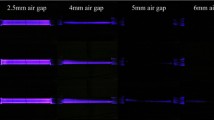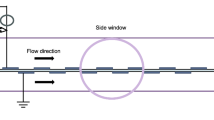Abstract
Ozone production in a planar dielectric barrier discharge (DBD) in atmospheric oxygen in different discharge modes was investigated. Results show that the gas temperature in discharge channel depends strongly on discharge mode, with a value of 300–310 K in glow regime and 440–465 K in streamer regime. Ozone production yield in glow DBD is much higher than that in streamer one, with the best yield of 342.6 and 162.6 g/kWh, respectively. Gas temperature in discharge channel relates to the effective discharge area of DBD, which is a small fraction of the whole electrode surface in streamer DBD compared with nearly the whole surface in glow DBD. The gas temperature in the channel plays a decisive role in the conversion of oxygen atoms to ozone as well as the ozone equilibrium concentration. Excellent performance of glow DBD demonstrates the high energy efficiency and reliability for practical application of planar DBD-based ozone generator.









Similar content being viewed by others
Availability of Data and Materials
All data generated or analysed during this study are included in thispublished article and its supplementary information files.
References
He X, Liu X, Li P, Wang P, Cheng H, Li W, Li B, Liu T, Ma J (2022) A multi-stage green barrier strategy for the control of global SARS-CoV-2 transmission via cold chain goods. Engineering (Beijing, China) 9:13
Gucker SN, Foster JE, Garcia MC (2015) An investigation of an underwater steam plasma discharge as alternative to air plasmas for water purification. IOP Publishing
Pavlovich MJ, Chang H-W, Sakiyama Y, Clark DS, Graves DB (2013) Ozone correlates with antibacterial effects from indirect air dielectric barrier discharge treatment of water. J Phys D Appl Phys 46(14):145202
Shaw D, West A, Bredin J, Wagenaars E (2016) Mechanisms behind surface modification of polypropylene film using an atmospheric-pressure plasma jet. Plasma Sources Sci Technol 25(6):065018
Bekeschus S, Brüggemeier J, Hackbarth C, Weltmann K-D, Von Woedtke T, Partecke L-I, Linde J (2018) The feed gas composition determines the degree of physical plasma-induced platelet activation for blood coagulation. Plasma Sources Sci Technol 27(3):034001
Von Woedtke T, Laroussi M, Gherardi M (2022) Foundations of plasmas for medical applications. Plasma Sources Sci Technol 31(5):054002
Mitsugi F, Ebihara K, Horibe N, Aoqui S-I, Nagahama K (2017) Practical soil treatment in a greenhouse using surface barrier discharge ozone generator. IEEE Trans Plasma Sci 45(12):3082–3088
Wen G, Liang Z, Xu X, Cao R, Wan Q, Ji G, Lin W, Wang J, Yang J, Huang T (2020) Inactivation of fungal spores in water using ozone: kinetics, influencing factors and mechanisms. Water Res 185:116218
Guo L, Yao Z, Yang L, Zhang H, Qi Y, Gou L, Xi W, Liu D, Zhang L, Cheng Y et al (2021) Plasma-activated water: an alternative disinfectant for s protein inactivation to prevent SARS-CoV-2 infection. Chem Eng J 421:127742
Fernández-Cuadros ME, Albaladejo-Florín MJ, Peña-Lora D, Álava-Rabasa S, Pérez-Moro OS (2020) Ozone (O3) and SARS-CoV-2: physiological bases and their therapeutic possibilities according to COVID-19 evolutionary stage. SN Compr Clin Med 2:1094–1102
Nassour K, Brahami M, Nemmich S, Hammadi N, Zouzou N, Tilmatine A (2016) Comparative experimental study between surface and volume DBD ozone generator. Ozone Sci Eng 38(1):70–76
Teranishi K, Shimomura N, Suzuki S, Itoh H (2009) Development of dielectric barrier discharge-type ozone generator constructed with piezoelectric transformers: effect of dielectric electrode materials on ozone generation. Plasma Sources Sci Technol 18(4):045011
Valdivia-Barrientos R, Pacheco-Sotelo J, Pacheco-Pacheco M, Benítez-Read J, López-Callejas R (2006) Analysis and electrical modelling of a cylindrical DBD configuration at different operating frequencies. Plasma Sources Sci Technol 15(2):237
Homola T, Pongrác B, Zemánek M, Šimek M (2019) Efficiency of ozone production in coplanar dielectric barrier discharge. Springer, New York
Homola T, Prukner V, Hoffer P, Šimek M (2020) Multi-hollow surface dielectric barrier discharge: an ozone generator with flexible performance and supreme efficiency. Plasma Sources Sci Technol 29(9):095014
Li M, Yan Y, Zhang L, Zhou Z, Zheng L, Zhu B, Wang L, Li T, Tang X, Zhu Y (2019) Promoting ozone synthesis from oxygen by a high performance volume-surface hybrid discharge. Appl Phys Lett 114(11)
Shang K, Wang M, Peng B, Li J, Lu N, Jiang N, Wu Y (2019) Characterization of a novel volume-surface DBD reactor: discharge characteristics, ozone production and benzene degradation. J Phys D Appl Phys 53(6):065201
Cho J, Koo I, Choi M, Lee W (2008) Ozone production by nanoporous dielectric barrier glow discharge in atmospheric pressure air. Appl Phys Lett 92(10)
Osawa N, Tsuji T, Ogiso R, Yoshioka Y (2017) Effect of nitrogen addition to ozone generation characteristics by diffuse and filamentary dielectric barrier discharges at atmospheric pressure. Eur Phys J Appl Phys 78(2):20804
Liu P, Song Y, Zhang Z (2021) A novel dielectric barrier discharge (DBD) reactor with streamer and glow corona discharge for improved ozone generation at atmospheric pressure. Micromachines 12(11):1287
Teranishi K, Shimomura N, Suzuki S, Itoh H (2009) Development of dielectric barrier discharge-type ozone generator constructed with piezoelectric transformers: effect of dielectric electrode materials on ozone generation. Plasma Sources Sci Technol 18(4):045011
Al-Abduly A, Christensen P, Harvey A (2020) The characterization of a packed bed plasma reactor for ozone generation. Plasma Sources Sci Technol 29(3):035002
Capp SC, Sawtell DA, Banks CE, Kelly PJ, Abd-Allah Z (2021) The effect of \(\text{ TiO}_{2}\) coatings on the formation of ozone and nitrogen oxides in non-thermal atmospheric pressure plasma. J Environ Chem Eng 9(5):106046
Seri P, Wright A, Shaw A, Iza F, Bandulasena H, Borghi CA, Neretti G (2019) Influence of the voltage waveform’s shape and on-time duration on the dissolved ozone produced by a DBD bubble reactor. Plasma Sources Sci Technol 28(3):035001
Yuan D, Ding C, He Y, Wang Z, Kumar S, Zhu Y, Cen K (2017) Characteristics of dielectric barrier discharge ozone synthesis for different pulse modes. Plasma Chem Plasma Process 37:1165–1173
Wei L, Pongrac B, Zhang Y, Liang X, Prukner V, Šimek M (2018) Influence of duty cycle on ozone generation and discharge using volume dielectric barrier discharge. Plasma Chem Plasma Process 38:355–364
Šimek M, Pekárek S, Prukner V (2010) Influence of power modulation on ozone production using an ac surface dielectric barrier discharge in oxygen. Plasma Chem Plasma Process 30:607–617
Pekárek S, Mikeš J, Krỳsa J (2015) Comparative study of \(\text{ TiO}_{2}\) and ZnO photocatalysts for the enhancement of ozone generation by surface dielectric barrier discharge in air. Appl Catal A 502:122–128
Vezzu G, Lopez JL, Freilich A, Becker KH (2009) Optimization of large-scale ozone generators. IEEE Trans Plasma Sci 37(6):890–896
Kogelschatz U, Eliasson B, Hirth M (1988) Ozone generation from oxygen and air: discharge physics and reaction mechanisms
Jodzis S (2013) Temperature effects under ozone synthesis process conditions. Eur Phys J Appl Phys 61(2):24319
Jodzis S, Zikeba M (2018) Energy efficiency of an ozone generation process in oxygen: analysis of a pulsed DBD system. Vacuum 155:29–37
Jodzis S, Baran K (2022) The influence of gas temperature on ozone generation and decomposition in ozone generator: how is ozone decomposed? Vacuum 195:110647
Bruggeman PJ, Sadeghi N, Schram D, Linss V (2014) Gas temperature determination from rotational lines in non-equilibrium plasmas: a review. Plasma Sources Sci Technol 23(2):023001
Lin K-M, Ku C-M, Cheng C-H (2019) Statistical behavior of a single microdischarge in atmospheric-pressure air dielectric barrier discharges. Phys Plasmas 26(1)
Liu K, Geng W, Zhou X, Duan Q, Zheng Z, Ostrikov KK (2023) Transition mechanisms between selective O3 and NO x generation modes in atmospheric-pressure plasmas: decoupling specific discharge energy and gas temperature effects. Plasma Sources Sci Technol 32(2):025005
Liu Z-J, Wang W-C, Yang D-Z, Wang S, Zhang S, Tang K, Jiang P-C (2014) A large-area diffuse air discharge plasma excited by nanosecond pulse under a double hexagon needle-array electrode. Spectrochim Acta Part A Mol Biomol Spectrosc 121:698–703
Hamburger C (1995) Quasimonotonicity, regularity and duality for nonlinear systems of partial differential equations. Ann Mat 169:321–354
Mennad B, Harrache Z, Aid DA, Belasri A (2010) Theoretical investigation of ozone production in negative corona discharge. Curr Appl Phys 10(6):1391–1401
Eliasson B, Hirth M, Kogelschatz U (1987) Ozone synthesis from oxygen in dielectric barrier discharges. J Phys D Appl Phys 20(11):1421
Acknowledgements
This work was supported by the National Natural Science Foundation of China (No. 52077006), the Beijing Natural Science Foundation (No. 7232332).
Funding
This work was supported by National Natural Science Foundation of China (No. 11975047).
Author information
Authors and Affiliations
Contributions
Conceptualization, JL; methodology, JL and JO; software, JY; validation, FH, and JO; formal analysis, JL; investigation, JL and JY; resources, FH, and JO; data curation, JL; writing–original draft preparation, JL; writing–review and editing, JL and FH; visualization, JY; supervision, FH; project administration, FH; funding acquisition, JO. All authors reviewed the manuscript.
Corresponding author
Ethics declarations
Conflict of interest
The authors have no competing interests to declare that are relevant to the content of this article.
Ethical Approval
Not applicable.
Additional information
Publisher's Note
Springer Nature remains neutral with regard to jurisdictional claims in published maps and institutional affiliations.
Rights and permissions
Springer Nature or its licensor (e.g. a society or other partner) holds exclusive rights to this article under a publishing agreement with the author(s) or other rightsholder(s); author self-archiving of the accepted manuscript version of this article is solely governed by the terms of such publishing agreement and applicable law.
About this article
Cite this article
Li, J., Yao, J., He, F. et al. Comparison of Ozone Production in Planar DBD of Different Modes. Plasma Chem Plasma Process 44, 891–905 (2024). https://doi.org/10.1007/s11090-024-10452-0
Received:
Accepted:
Published:
Issue Date:
DOI: https://doi.org/10.1007/s11090-024-10452-0




